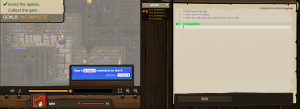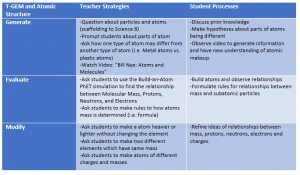Many concepts are difficult for students to understand without some form of visualization to aid the description. This week I have integrated T-GEM with a water conductivity PhET Simulation to create a lesson activity which can address misconceptions. A regular misconception that students have is that pure water conducts electricity. By the end of this lesson students should be able to communicate what makes water conductive.
Step 1: Introduction
-Students form groups of 2-3, each group will have a computer, paper, and writing utensil
-Review as a class:
1 – What is electricity? What is flowing?
2 – How do we make electricity?
3 – What is concentration (with respect to dissolved solids)?
4 – How could we make things more or less concentrated?
Step 2: Generate
Have students as a group generate ideas around the following key questions:
1 – Is water conductive?
2 – How does electricity move in water?
3 – Would dissolving solids in the water change its properties?
Each group will write their predictions down on a piece of paper.
Step 3: Evaluate
Have groups use PhET Simulation “Sugar and Solutions” to investigate water conductivity.
Ask students to test if their predictions are correct.
Step 4: Modify
Ask students to create a situation where their new knowledge of water conductivity could be useful.
(The use of Makey-Makeys can be used so students can make an apparatus which physically uses water conductivity to control a computer)
Step 5: Reflect
Have students revise their original ideas and together formulate the main points of water conductivity.
References
Friedrichsen, P. M., & Pallant, A. (2007). French fries, dialysis tubing & computer models: Teaching diffusion & osmosis through inquiry & modeling. The American Biology Teacher, 69(2), 22-27.
Khan, S. (2010). New Pedagogies on Teaching Science with Computer Simulations. J Sci Educ Technol, 20(3), 215–232. http://doi.org/10.1007/s10956-010-9247-2
Srinivasan, S., Perez, L. C., Palmer,R., Brooks,D., Wilson,K., & Fowler. D. (2006). Reality versus simulation. Journal of Science Education and Technology, 15 (2), 137-141. http://ezproxy.library.ubc.ca/login?url=http://dx.doi.org/10.1007/s10956-006-9007-5

